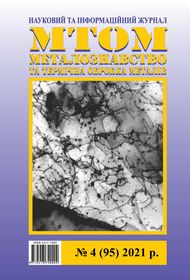DEGRADATION OF INCLUSION − MATRIX BOUNDARIES IN ACTIVE ENVIRONMENTS
DOI:
https://doi.org/10.30838/J.PMHTM.2413.281221.45.823Keywords:
steel; non-metallic inclusions; interphase inclusion-matrix boundaries; stresses; defects; corrosion; aggressive environment; wearAbstract
Purpose. The aim of the work was to analyze the features of the destruction of the inclusion − matrix interphase boundaries under aggressive influences and in the process of wear as a result of the degradation of their structure. Methods. The samples of steels 08, R7, ShKh15 were tested for low-cycle fatigue in air and in corrosive environments (1…5 % aqueous solution of NaCl and 2…1 % aqueous solution of H2SO4). A test method was used to test the tendency of steels to stress corrosion cracking on an IM-12 installation. Fatigue strength tests were carried out on an NU machine. Samples of steels 08kp, 08Yu, 08GSYuTF, ShKh15, R7, M74 were exposed to holding in an atmosphere of hydrogen for 2 h at of 650 and 1 100 °C, the pressure 5 and 10 MPa. The features of the wear of the rolling surface of railway wheels (steel R7), which have worked for 5 years under a passenger train, have been investigated. Research methods: metallographic ("Neophot-21"), electron microscopic ("JSM-35"), petrographic. Results. The features of the fracture of the interphase inclusion − matrix boundaries under various thermal-deformation and aggressive actions are investigated. The role of inclusion − matrix boundaries in the formation of cracks of fatigue, fatigue-corrosion and hydrogen origin is considered. Scientific novelty. It is shown that under the influence of aggressive media and cyclic stresses, the structure of the inclusion − matrix interphase boundaries degrades, which is associated not only with the accumulation of interfacial stresses, but also with the facilitation of the penetration of surfactant atoms from the environment along these boundaries. As a result, fatigue-corrosion destruction of the inclusion − matrix boundaries occurs, and the effect of an adsorptive decrease in their strength is manifested. Practical significance. The research results can be useful in the development of methods of targeted influence on non-metallic inclusions and inclusion − matrix boundaries in various types of steel processing and the operation of steel products.

Downloads
Published
Issue
Section
License
Authors that are published in this journal agree to follow the conditions:
Authors reserve the right to the authorship of his work and cede the right to the journal of first publication of this work on conditions of the license under the Creative Commons Attribution License, which allows others to distribute it freely with the obligatory reference to the author of the original work and the first publication of the work in this journal.
